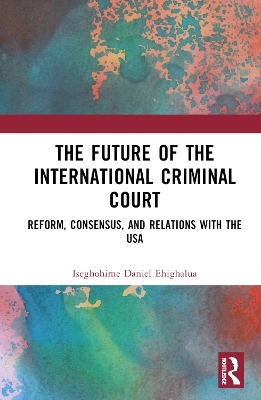
The Future of the International Criminal Court
Routledge (Verlag)
978-1-032-44204-4 (ISBN)
Dr Iseghohime Daniel Ehighalua is a Human Rights lawyer. His research interests include international human rights law, international criminal law, justice sector reform and good governance. He is a former Secretary of the Nigerian Coalition for the International Criminal Court.
1 The Establishment of the International Criminal Court: Prospects, Challenges, and Tensions
Introductory Background
Framing the Research: Identifying the Gaps and Problem Statement
Norms: Formation, Duration, Consolidation, and Internalization
Is the Rules-Based Order Constraining the Court?
Theoretical and Conceptual Framework
Scoping the Book
Critical Questions: Legal Propositions and Factual Arguments
Framing and Negotiating U.S. Decision Regarding the Court: National v. Vital Interest
Interrogating the Fate of the Court and its Impact
Competing Visions of Global Order
Reviewing the Literature
Is the Vision still Realizable?
The Literature on the Court’s Survival
The Problematics of the U.S. Relationship with the Court
Sovereignty, Non-intervention, and the Modern Nation-State
Political and Constitutional Sovereignty
"America Firstism"
United States’ Broad Aversion to International Law
Concluding Thoughts on the Relationship
A Synopsis of the Issues: Positionality Statement
Bibliography
2 How History and Geopolitics Shape the Formation of International Courts
Introductory Overview
Why History Matters
The Primacy of Building Political Consensus among Major Powers
Legal Framework: The Rome Statute 1998
Current Institutional Design and Organizational Structure
Assembly of States Parties – ASP (The Assembly)
The Chambers and the Prosecutor: Overlapping Authority?
The Chambers and Presidency
The Office of the Prosecutor – OTP
The Trust Fund for Victims
The Rome Conference: Was an Alternative Treaty Regime Feasible?
Between the Prosecutor, UNSC, and the Chambers: Working at Cross Purposes?
Admissibility Test: Complementarity and the Gravity Threshold
Waiver of Immunity and Irrelevance of Official Capacity
Conclusion
Bibliography
3 Between the Court’s Performance and U.S. Hostility: Will the Court Survive?
General Overview
Constructing National or Vital Interests: A Framework for Understanding the U.S. Position
Appraising Bill Clinton’s Engagement Strategy
George Bush II: Confrontation and Roll-back
Barack Obama’s Re-engagement Strategy
Trump’s Belligerence and "Principled Realism"
Does it Matter if the United States Continues to Remain at the Margins?
Bringing it all Together
Domestication: U.S. Executive and Congressional Procedures
A Vision Unmatched by Performance
Legal Metrics
A Range of Non-legal Metrics
How Funding Shape Perceptions
Staffing: Dearth and Quality
Perception as Realities
Pining for Regional Courts
Geopolitics and National Interest: A Balancing Act
Reconciling National Interests Writ Large
Africa’s Geopolitical Question: Perceptions of Justice
Closing Summary
Bibliography
4 Competing Visions of Global Order, the Court, and International Crimes
Introduction
The Way the World Works or Should Work
The United Nations System and International Crimes
Variations in Global Order
Polarizing the World
Unipolarity, Bipolarity, and Multipolarity
A Multiplex World
Global Concert Model
Regional Worlds Model
Conclusion: What Comes Next?
Will a New Court Cut it?
Bibliography
5 Mechanics for Rescuing the Court: Toward a "Pragmatist Realist" Vision
Introduction
Norms: Defiance and Hierarchy
Defining Norms
Typology of Norms
Peremptory Norms or Jus Cogens
Defying the Statute, Resisting the Court
A Grotian Moment?
A New Institutional Design
Reforms and Recommendations
The Office of the Prosecutor and Seven Deputy Prosecutors
A Rule of Law Prosecutor
Why Regionalizing the Prosecutor’s Office Matters
Legal Pluralism: Incorporating Local Justice Initiatives
Redrawing Boundaries: The Prosecutor and Chambers
Reviewing the Politico-Strategic Decisions
Enlarging the Political Role of the ASP/President: Why it Matters
Amending the Statute: Reworking Policies and Strategies
Part 2 of the Statute
Part 3 of the Statute
Part 4 of the Statute
Part 5 of the Statute
Part 9 of the Statute
Conclusion
Bibliography
6 Reforming the International Criminal Court, Building Consensus, and Resolving the Survival Question
A Synopsis of the Hypothesis
On Re-envisioning the Court
U.S. Continued Engagement at the Margins: What it Forebodes and Why it Matters
Tangential Hypothesis
Bibliography
| Erscheinungsdatum | 10.07.2023 |
|---|---|
| Zusatzinfo | 3 Line drawings, black and white; 3 Illustrations, black and white |
| Verlagsort | London |
| Sprache | englisch |
| Maße | 156 x 234 mm |
| Gewicht | 650 g |
| Themenwelt | Recht / Steuern ► EU / Internationales Recht |
| Recht / Steuern ► Öffentliches Recht | |
| Recht / Steuern ► Strafrecht ► Kriminologie | |
| Recht / Steuern ► Strafrecht ► Strafverfahrensrecht | |
| ISBN-10 | 1-032-44204-2 / 1032442042 |
| ISBN-13 | 978-1-032-44204-4 / 9781032442044 |
| Zustand | Neuware |
| Haben Sie eine Frage zum Produkt? |
aus dem Bereich


